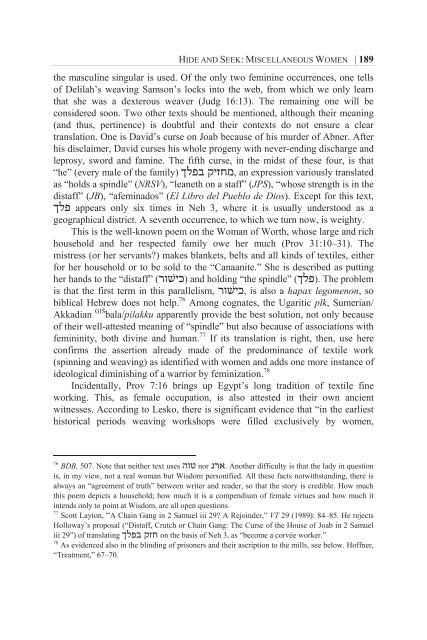Women at Work in the Deuteronomistic History - International Voices ...
Women at Work in the Deuteronomistic History - International Voices ...
Women at Work in the Deuteronomistic History - International Voices ...
Create successful ePaper yourself
Turn your PDF publications into a flip-book with our unique Google optimized e-Paper software.
HIDE AND SEEK: MISCELLANEOUS WOMEN | 189<br />
<strong>the</strong> mascul<strong>in</strong>e s<strong>in</strong>gular is used. Of <strong>the</strong> only two fem<strong>in</strong><strong>in</strong>e occurrences, one tells<br />
of Delilah’s weav<strong>in</strong>g Samson’s locks <strong>in</strong>to <strong>the</strong> web, from which we only learn<br />
th<strong>at</strong> she was a dexterous weaver (Judg 16:13). The rema<strong>in</strong><strong>in</strong>g one will be<br />
considered soon. Two o<strong>the</strong>r texts should be mentioned, although <strong>the</strong>ir mean<strong>in</strong>g<br />
(and thus, pert<strong>in</strong>ence) is doubtful and <strong>the</strong>ir contexts do not ensure a clear<br />
transl<strong>at</strong>ion. One is David’s curse on Joab because of his murder of Abner. After<br />
his disclaimer, David curses his whole progeny with never-end<strong>in</strong>g discharge and<br />
leprosy, sword and fam<strong>in</strong>e. The fifth curse, <strong>in</strong> <strong>the</strong> midst of <strong>the</strong>se four, is th<strong>at</strong><br />
“he” (every male of <strong>the</strong> family) ךלפב קיזחמ, an expression variously transl<strong>at</strong>ed<br />
as “holds a sp<strong>in</strong>dle” (NRSV), “leaneth on a staff” (JPS), “whose strength is <strong>in</strong> <strong>the</strong><br />
distaff” (JB), “afem<strong>in</strong>ados” (El Libro del Pueblo de Dios). Except for this text,<br />
ךלפ appears only six times <strong>in</strong> Neh 3, where it is usually understood as a<br />
geographical district. A seventh occurrence, to which we turn now, is weighty.<br />
This is <strong>the</strong> well-known poem on <strong>the</strong> Woman of Worth, whose large and rich<br />
household and her respected family owe her much (Prov 31:10–31). The<br />
mistress (or her servants?) makes blankets, belts and all k<strong>in</strong>ds of textiles, ei<strong>the</strong>r<br />
for her household or to be sold to <strong>the</strong> “Canaanite.” She is described as putt<strong>in</strong>g<br />
her hands to <strong>the</strong> “distaff” (רושׁיכ) and hold<strong>in</strong>g “<strong>the</strong> sp<strong>in</strong>dle” (ךלפ). The problem<br />
is th<strong>at</strong> <strong>the</strong> first term <strong>in</strong> this parallelism, רושׁיכ, is also a hapax legomenon, so<br />
biblical Hebrew does not help. 76 Among cogn<strong>at</strong>es, <strong>the</strong> Ugaritic plk, Sumerian/<br />
Akkadian GIŠ bala/pilakku apparently provide <strong>the</strong> best solution, not only because<br />
of <strong>the</strong>ir well-<strong>at</strong>tested mean<strong>in</strong>g of “sp<strong>in</strong>dle” but also because of associ<strong>at</strong>ions with<br />
fem<strong>in</strong><strong>in</strong>ity, both div<strong>in</strong>e and human. 77 If its transl<strong>at</strong>ion is right, <strong>the</strong>n, use here<br />
confirms <strong>the</strong> assertion already made of <strong>the</strong> predom<strong>in</strong>ance of textile work<br />
(sp<strong>in</strong>n<strong>in</strong>g and weav<strong>in</strong>g) as identified with women and adds one more <strong>in</strong>stance of<br />
ideological dim<strong>in</strong>ish<strong>in</strong>g of a warrior by fem<strong>in</strong>iz<strong>at</strong>ion. 78<br />
Incidentally, Prov 7:16 br<strong>in</strong>gs up Egypt’s long tradition of textile f<strong>in</strong>e<br />
work<strong>in</strong>g. This, as female occup<strong>at</strong>ion, is also <strong>at</strong>tested <strong>in</strong> <strong>the</strong>ir own ancient<br />
witnesses. Accord<strong>in</strong>g to Lesko, <strong>the</strong>re is significant evidence th<strong>at</strong> “<strong>in</strong> <strong>the</strong> earliest<br />
historical periods weav<strong>in</strong>g workshops were filled exclusively by women,<br />
76 BDB, 507. Note th<strong>at</strong> nei<strong>the</strong>r text uses הוט nor גרא. Ano<strong>the</strong>r difficulty is th<strong>at</strong> <strong>the</strong> lady <strong>in</strong> question<br />
is, <strong>in</strong> my view, not a real woman but Wisdom personified. All <strong>the</strong>se facts notwithstand<strong>in</strong>g, <strong>the</strong>re is<br />
always an “agreement of truth” between writer and reader, so th<strong>at</strong> <strong>the</strong> story is credible. How much<br />
this poem depicts a household; how much it is a compendium of female virtues and how much it<br />
<strong>in</strong>tends only to po<strong>in</strong>t <strong>at</strong> Wisdom, are all open questions.<br />
77 Scott Layton, “A Cha<strong>in</strong> Gang <strong>in</strong> 2 Samuel iii 29? A Rejo<strong>in</strong>der,” VT 29 (1989): 84–85. He rejects<br />
Holloway’s proposal (“Distaff, Crutch or Cha<strong>in</strong> Gang: The Curse of <strong>the</strong> House of Joab <strong>in</strong> 2 Samuel<br />
iii 29”) of transl<strong>at</strong><strong>in</strong>g ךלפב קזח on <strong>the</strong> basis of Neh 3, as “become a corvée worker.”<br />
78 As evidenced also <strong>in</strong> <strong>the</strong> bl<strong>in</strong>d<strong>in</strong>g of prisoners and <strong>the</strong>ir ascription to <strong>the</strong> mills, see below. Hoffner,<br />
“Tre<strong>at</strong>ment,” 67–70.




